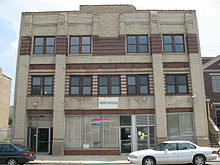This article relies largely or entirely on a single source .(December 2018) |

The Chicago Defender Building, located at 3435 S. Indiana Avenue in the Black Metropolis-Bronzeville District [1] of the Douglas community area of Chicago, Illinois, housed the Chicago Defender from 1920 until 1960. [2] Designed by Henry L. Newhouse, it was originally a synagogue. The building was designated a Chicago Landmark on September 9, 1998. [2]

